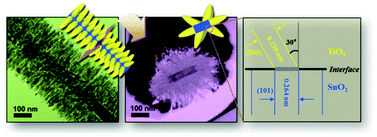Tailoring nanobranches in three-dimensional hierarchical rutile heterostructures: a case study of TiO2–SnO2†
Abstract
We employed

* Corresponding authors
a
Department of Materials Science and Engineering, Seoul National University, Seoul 151-744, Korea
E-mail:
kshong@plaza.snu.ac.kr
Fax: +82 2 886 4156
Tel: +82 2 880 8024
b Department of Material Science and Engineering, University of California at Berkeley, CA 94709, USA
c
Department of Materials Science and Engineering, Ajou University, San 5, Woncheon-dong, Yeongtong-gu, Suwon 443-749, Korea
E-mail:
dwkim@ajou.ac.kr
Tel: +82 31 219 3248
We employed

 Please wait while we load your content...
Something went wrong. Try again?
Please wait while we load your content...
Something went wrong. Try again?
S. Park, S. Lee, S. W. Seo, S. Seo, C. W. Lee, D. Kim, D. Kim and K. S. Hong, CrystEngComm, 2013, 15, 2939 DOI: 10.1039/C3CE26722A
To request permission to reproduce material from this article, please go to the Copyright Clearance Center request page.
If you are an author contributing to an RSC publication, you do not need to request permission provided correct acknowledgement is given.
If you are the author of this article, you do not need to request permission to reproduce figures and diagrams provided correct acknowledgement is given. If you want to reproduce the whole article in a third-party publication (excluding your thesis/dissertation for which permission is not required) please go to the Copyright Clearance Center request page.
Read more about how to correctly acknowledge RSC content.
 Fetching data from CrossRef.
Fetching data from CrossRef.
This may take some time to load.
Loading related content
